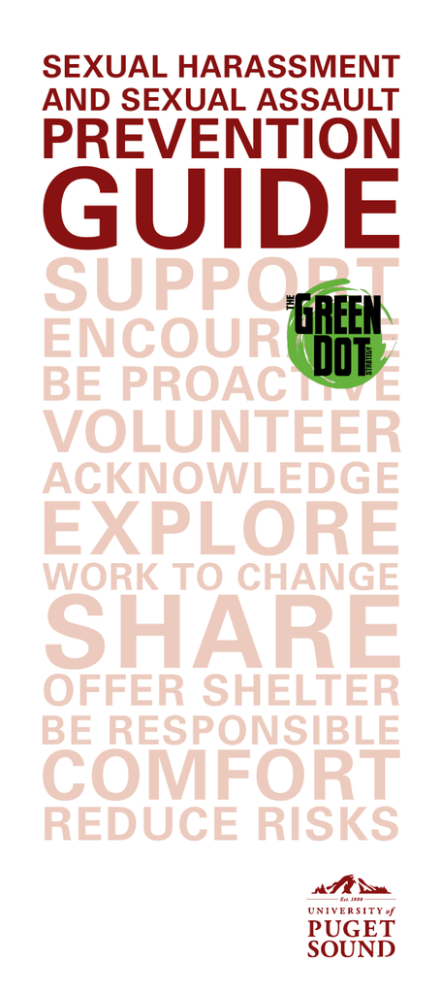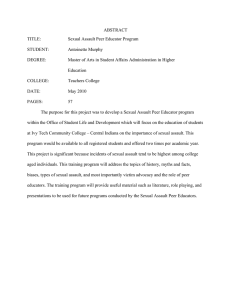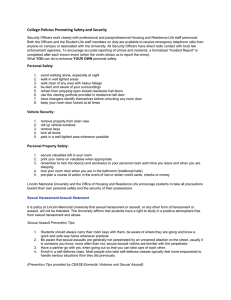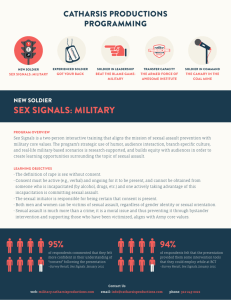
SEXUAL HARASSMENT
AND SEXUAL ASSAULT
PREVENTION
GUIDE
SUPPORT
ENCOURAGE
BE PROACTIVE
VOLUNTEER
ACKNOWLEDGE
EXPLORE
WORK TO CHANGE
SHARE
OFFER SHELTER
BE RESPONSIBLE
COMFORT
REDUCE RISKS
“
What you need to know
about me is that I believe that
violence is crap…That we all
deserve to be safe…That I
know what to do to make our
community safer…And that I
will step up if I need to…but
most of all, you need to know
that I expect you to do the
same.”
No one has to
do everything.
But everyone
has to do
something.
Sexual misconduct will not be tolerated within the college
community as it is harmful to both the learning environment and the sense of community the college fosters
among students, faculty, staff, and administrators.
From the Policy Prohibiting Harassment
and Sexual Misconduct
2
Myths
Myth: Rape is a rare occurrence.
Fact: Between one in four and one in five college women
will experience rape or attempted rape over the course
of a five-year college career (Fisher, Cullen, and Turner,
December 2000).
Fact: 80–90 percent of assaults and attempted assaults
are never reported.
Myth: If women were more cautious in avoiding
strangers, they would not be raped.
Fact: Almost four out of five rapes were committed by
someone known to the victim, such as a friend or acquaintance. (Rape in America: A Report to the Nation. National
Center for Victims of Crime and Crime Victims Research
and Treatment Center: Arlington, VA, 1992.)
Myth: A person cannot be sexually assaulted by
his/her partner.
Fact: Sexual assault is a crime regardless of the relationship between the victim and offender. Victims of intimate
partner assault are less likely to report the assault for fear
that they will not be believed or because of their emotional investment in the relationship.
Myth: Victims of sexual assault are always bruised and
visibly shaken. Otherwise it is not a real assault/rape.
Fact: There are many responses to the trauma of sexual
assault. The threat of physical harm and the surprise
of the attack can immobilize a person with fear. Sexual
assault is sexual contact that is perpetrated against the
victim’s will—most of the damage is nonphysical.
Myth: Men are not at risk for being sexually assaulted.
Fact: Men can be assaulted, too. Men are most likely
to be assaulted by another man or group of men. Often
weapons or alcohol are involved. Being raped has nothing to do with the victim’s sexuality or homophobic social
attitudes.
3
KNOW
YOUR
RIGHTS
•Nobody has the right to touch you without your
permission.
•You have the ability to communicate your sexual
interests and limits.
•When you are unsure, you have the right to STOP
and TALK ABOUT IT.
•You may choose to be sexually intimate when
both you and your partner are comfortable with
that decision.
•You may choose sexual abstinence.
•You always have the right to refrain from sexual
activity.
•You may choose to walk away from a situation at
any time.
•You don’t have to “hook up” because the night is
still young.
•You don’t have to go along with something that
you’re not ready to do.
•You do not need to respond to pressure to “be
alone” until you are ready.
•You can think for yourself.
•You must be fully conscious and awake in order
to give consent.
•Consent cannot be given if your partner is under
the influence of alcohol or drugs.
4
Act Responsibly: Prevent and
Reduce the Risk of an Assault
BE PROACTIVE
•Talk about sexual assault.
•Educate and inform yourself about sexual assault and
harassment.
•Look for teaching moments to educate your peers that
sexual assault is NEVER okay.
• Develop educational programs in your residence hall,
Greek chapter, campus club, or organization.
SUPPORT survivors of violent crimes. No matter what
they were wearing, whom they were with, where they
were going—they did not ask to be harassed, raped, or
assaulted.
•Do not downplay assault or harassment.
•Do not share or laugh at inappropriate jokes, comments,
or stories about assault or harassment.
•Attend or participate in a campus or community program
about sexual assault.
REJECT behavior or attitudes that excuse harassment or
rape, or that glorify violence.
•Interrupt a situation that appears to be headed in the
wrong direction, even if you risk angering a friend.
•Send a clear message that assault will not be tolerated.
VOLUNTEER at an organization dedicated to ending
interpersonal violence, such as a sexual assault center or
a YWCA Battered Women’s Shelter.
EXPLORE, ACKNOWLEDGE, and WORK to change the
violent impulses we all sometimes feel.
•Don’t try to read alternate meanings into an answer
about sexual involvement.
•Be assertive and confident in your communication. Passivity may be falsely interpreted as permission.
•Before acting be certain permission is clear both verbally
and nonverbally. Sometimes people “freeze” in stressful
situations so they cannot communicate effectively. Do
not accept passivity as permission.
Prevention focuses on the potential perpetrator.
Risk reduction focuses on the potential victim.
5
How to Help a Friend
Who Has Been Assaulted
It is common for survivors to feel confused, ashamed,
guilty, dirty, frightened, helpless, damaged, distrustful,
etc. Remember whatever a survivor feels is understandable, given his or her experience. Everyone has a unique
response to being assaulted.
OFFER SHELTER. See that the victim has a safe place to
stay and does not have to be alone until ready.
BE SUPPORTIVE. Offer the victim emotional comfort
and support. Encourage the expression of feelings. Don’t
ask for details, but be willing to listen if the victim wants
to talk. If you are not comfortable listening empathetically,
help the victim find someone who is.
ENCOURAGE ACTION. Gently encourage these four
things: stay in a safe place, get medical attention, seek
counseling, and report the rape, even if the assault occurred some time ago.
BE REASSURING. Rape is never the victim’s fault. Here
are some things you can say to someone who has been
sexually assaulted:
“I believe you.”
“You survived; you did the best you could under
the circumstances.”
“It is not your fault. Nothing you did could possibly
justify what happened.”
“I’m sorry it happened to you.”
“This does not change how I feel about you.”
“What can I do to help you?”
ENCOURAGE PROFESSIONAL SUPPORT. Refer your
friend for professional assistance and get support
for yourself!
6
Definitions
Sexual Assault
The act or attempt of sexual activity ranging from inappropriate and unwanted touching to intercourse that generates fear, shame, or mental or physical suffering.
Rape/Acquaintance Rape
The act of sexual contact, specifically sexual intercourse,
by force or without consent between partners.
Sexual Harassment
The act of making inappropriate, unwanted, and offensive
verbal or physical sexual remarks and/or advances.
Consent
Sexual contact that occurs without the explicit consent of
each partner involved may be considered sexual assault.
Consent must be clearly communicated, mutual, and
unforced.
Anyone impaired by drugs or alcohol is not capable of
giving consent. A student must be fully conscious and
awake in order to give consent.
*
Campus
Safety Tips
•Don’t prop open outside doors. Always
lock your room door.
•Use the campus escort service offered
24/7 by Security Services. (253.879.3311)
•Use the buddy system; make sure a
friend knows where you are.
•Watch out for others’ safety.
7
Resources
Counseling, Health, and Wellness Services....253.879.1555
Security Services.............................................. 253.879.3311
Dean of Students..............................................253.879.3360
University Chaplain.......................................... 253.879.3374
Rebuilding Hope: The Sexual Assault Center
of Pierce County.............................................. 253.474.RAPE
S.I.R.G.E.............................................................253.879.3373
Tacoma Police Department................ 253.593.4721 (or 911)
Tacoma General Hospital............................... 253.403.7537
For more complete details, see the university Policy
Prohibiting Harassment and Sexual Misconduct online:
www.pugetsound.edu/harassment-sexualmisconduct
This publication was developed by University of Puget
Sound to facilitate the understanding of sexual assault
and harassment to help create a safer environment.
Funding provided by the Division of Student Affairs.
No campus is safe from sexual harassment or assault.
(revised - 7/2013)
pugetsound.edu/greendot



